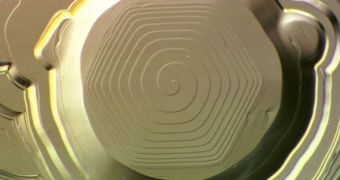Similar to the superfluidity property of helium, supersolidity occurs when matter is cooled at extremely low temperatures. The effect was discovered in 2004, when a team of researchers from the Penn State University, led by Dr. Moses Chan, announced that they had discovered another state of matter, by cooling solid helium and oscillating the material at different frequencies. Analysis of the data extracted from the experiment showed that particles inside the solid helium behaved in a way that suggested a 'perpetual flow' similar to the effect obtained in the superluidity helium experiment.
Since then physicists from the University of Alberta, in Edmonton, Canada, have brought major advances in understanding what happened when that so-called new state of matter occured. Results of the work, made by professor John Beamish from the Department of Physics, have been published in a paper of today's issue of the "Nature magazine".
In normal conditions of temperature and pressure, helium is a gas, but when cooled at low temperature, it turns into a liquid. When pressure is applied, the liquid turns into solid and physicists can observe its behavior while manipulating it in different ways.
In a novel experiment made by Dr. Beamish, scientists cooled solid helium and manipulated the material in an innovative way, by shearing its elasticity. This way, the solid behaved in a new and unexpected way, by becoming stiffer at lower temperatures, resulting in a shear modulus of the solid helium increase by 20 percent when the temperature drops bellow the 0.25 Kelvin temperature.
Moreover, it seems that the shear modulus follows the period change, produced by the torsional oscillator, and is dependent on the temperature, as the two separate phenomena are triggered by the same mechanical effect.
Other scientists, from all over the world, studying the supersolidity effect, have now turned their attention towards the possible implications of the discovery made by Dr. Beamish, which greatly contributed to the understanding of the fundamental states of matter allowed by nature.

 14 DAY TRIAL //
14 DAY TRIAL //